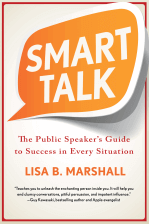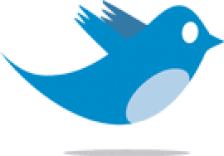10 Things I Wish I Had Known About Twitter
Happy birthday Twitter! The social media platform turns 8 years old today. The Public Speaker tells us 10 things she wishes she had known about Twitter from the beginning.
I want to start today’s episode by wishing Twitter a very happy eighth birthday! Twitter co-founder Jack Dorsey sent the very first tweet on March 21, 2006. Can you guess what he said?
Sponsor: Get started with a free 30-day trial of eVoice®.
just setting up my twttr
That’s right – the first words posted on Twitter were “just setting up my twttr.” In fact, the first 30 tweets were mostly people saying the exact same thing. There were a few other short tweets mixed in such as Dorsey’s second tweet “inviting coworkers” or the tweet that said “oh this is going to be addictive.”
I wasn’t there to see these first tweets. Even though people urged me to join Twitter in 2006 and 2007, I was reluctant to try it out. To be truthful, I just didn’t get it. To some extent, I still don’t fully get it and I’m just learning the best ways to use Twitter. When I read some of these early tweets, it’s clear to me that in the beginning, nobody really got it. It’s not even clear that the Twitter co-founders were exactly sure what they wanted it to be, let alone the best ways to use Twitter.
Eight years later, Twitter is more useful to me than Facebook.
When I ask my Smart Talk podcast guests what tools are most valuable to their business, more and more are saying Twitter. If you’re still not using Twitter, you may want to start now. If you’re already using Twitter, but aren’t quite sure what to do with it, let me share with you some of the lessons I’ve learned over the past 8 years.
Here are 10 things I wish I had known when I first joined Twitter:
-
Focus on others and inbound tweets first. Look for a group of people you can learn from. Find your colleagues. Follow local leaders, news makers, and topics you are interested in. For many people, Twitter has become their primary news source (particularly now that Facebook doesn’t propogate all messages to your newsfeed). And the reason for that is because Twitter allows you to essentially pick and choose the topics and people you’re most interested in. The trick is to organize the people and organizations you follow so that your customized news source doesn’t become overwhelming. For me, this is still something I struggle with, but it’s worth taking the time to sort out.
-
Curate inbound tweets. Retweet messages that really resonate with you. Some Twitter users form relationships and agree to mutually co-promote tweets. In some cases, it’s a loose informal agreement, while others have a more formal arrangement. You can even join groups for the purpose of mutually retweeting.
-
Whether you’re retweeting others or tweeting your own message, it’s important to always be consistent with your brand. Followers don’t like to see tweets that are off-brand. So if you aren’t clear about your branding, that is your very first step. And by the way, I am referring to both personal and corporate branding. Think about how you want your audience to percieve you and be sure that all of your tweets work together to create that perception.
-
Consider the 80/20 rule. For me, I like 80% of my tweets to link to useful information that I have created. Notice I said useful. That means the 80% consists mostly of articles, podcasts, or other free content that I have created. But in that 80% I also include a few personal tweets that share my values as well as encouraging or inspiring tweets that don’t include any links at all. On rare occassions, I’ll link to something I am offering for a fee. For the remaining 20% I try to retweet other people’s work. Although that has been my formula, I think it’s important to find a ratio that works for you, maybe it’s 70/30 or maybe it’s 10/90. I suggest experimenting and then deciding what works best.
-
Use tools to help you manage your tweets, but don’t just schedule your tweets and then forget about them. With all of your other responsibilities, you likely don’t have time to focus on Twitter all day. Tools like HootSuite and Buffer can help you create and schedule a good mix of tweets. But Twitter is all about conversations, so you’ll need to also check-in and interact daily. Interact with your followers. Your name and face matter. Answer questions; comment on other tweets. I know many people, particularly those with smartphones, who prefer to interact in real-time, while others who check-in once a day or so. Again, this is something that requires a bit of trial and error to calibrate to your particular needs.
-
If a tweet worked once, send it again.The life of a tweet is very short. If one of my tweets did well during the work week, I like to send it out again on the weekend. I also like to send a tweet at different times of the day. You’ll reach more of your audience this way, but be careful not to tweet the exact same thing over and over. You’ll need to experiment with which times work best for you. For me, most of the primary activity takes place between 8 and 9pm Eastern, so I’m always sure to tweet during this time slot.
-
If you are scheduling tweets in advance, be sure to monitor all of your activity in conjunction with the news cycle (particularly during national crises — you don’t want to seem insensitive). This is especially true if you have someone creating tweets for your business. Review them regularly for accuracy, applicability, and appropriatness. In addition, sometimes mistakes happen and you have to be on top of them quickly. Remember: Your repuation is at stake.
-
Keep your tweets as short as possible and include images. If your messages tend to be wordy, look for simpler ways to say the same thing. In my case, it seems the shorter the tweet, the more effective and images work better than links. Tweets with images get two times the engagement rate than tweets without images. If you are scheduling tweets, be sure to use a tool that brings in the images too.
-
Find different ways to make your tweets interesting and engaging. Some of your tweets should be straightforward, such as “10 tips for overcoming speaker nervousness” or “14 ways to be a better guest speaker.” But mix in some curiosity gap tweets too, such as “3 weird ways to introduce yourself” or “the single most important secret to being a better speaker.”
-
Do what works for you. You can ignore all the advice I just gave you–if you have found a different way works better for you! Everyone uses Twitter differently, so don’t judge what others do or try to model their approach exactly. Be yourself and do what is best for your audience and for your brand.
Sometimes I wish I had been one of those early Twitter pioneers, even if they were mostly tweeting things like “lunch” and “having pains in my back.” I may have been a little late, but I’m glad I joined when I did. I hope that by sharing what I’ve learned with you, I’ve encouraged you to get on board. Maybe I’ve even saved you from making some of my mistakes.
You can follow me on Twitter at @lisabmarshall. I’d love it if you posted a tweet letting me know what you thought about this episode.
Resources
Hootsuite Whitepaper on Enabling the Business with Social Relationship Platforms




 Whether you’re retweeting others or tweeting your own message, it’s important to always be consistent with your brand. Followers don’t like to see tweets that are off-brand. So if you aren’t clear about your branding, that is your very first step. And by the way, I am referring to both personal and corporate branding. Think about how you want your audience to percieve you and be sure that all of your tweets work together to create that perception.
Whether you’re retweeting others or tweeting your own message, it’s important to always be consistent with your brand. Followers don’t like to see tweets that are off-brand. So if you aren’t clear about your branding, that is your very first step. And by the way, I am referring to both personal and corporate branding. Think about how you want your audience to percieve you and be sure that all of your tweets work together to create that perception.  Keep your tweets as short as possible and include images. If your messages tend to be wordy, look for simpler ways to say the same thing. In my case, it seems the shorter the tweet, the more effective and images work better than links. Tweets with images get two times the engagement rate than tweets without images. If you are scheduling tweets, be sure to use a tool that brings in the images too.
Keep your tweets as short as possible and include images. If your messages tend to be wordy, look for simpler ways to say the same thing. In my case, it seems the shorter the tweet, the more effective and images work better than links. Tweets with images get two times the engagement rate than tweets without images. If you are scheduling tweets, be sure to use a tool that brings in the images too. 



